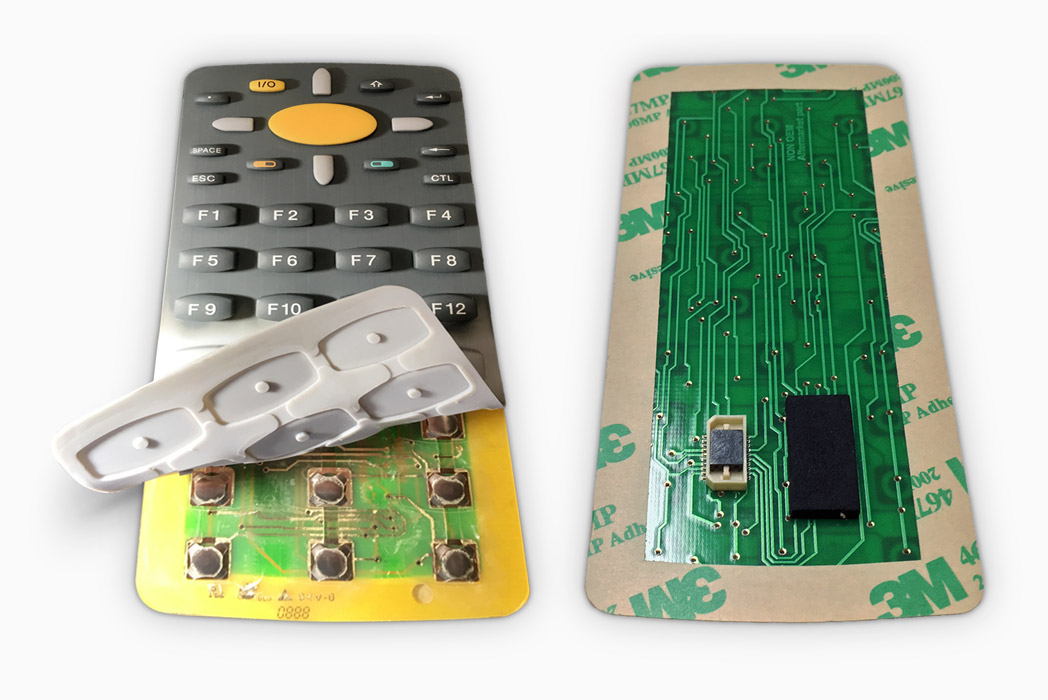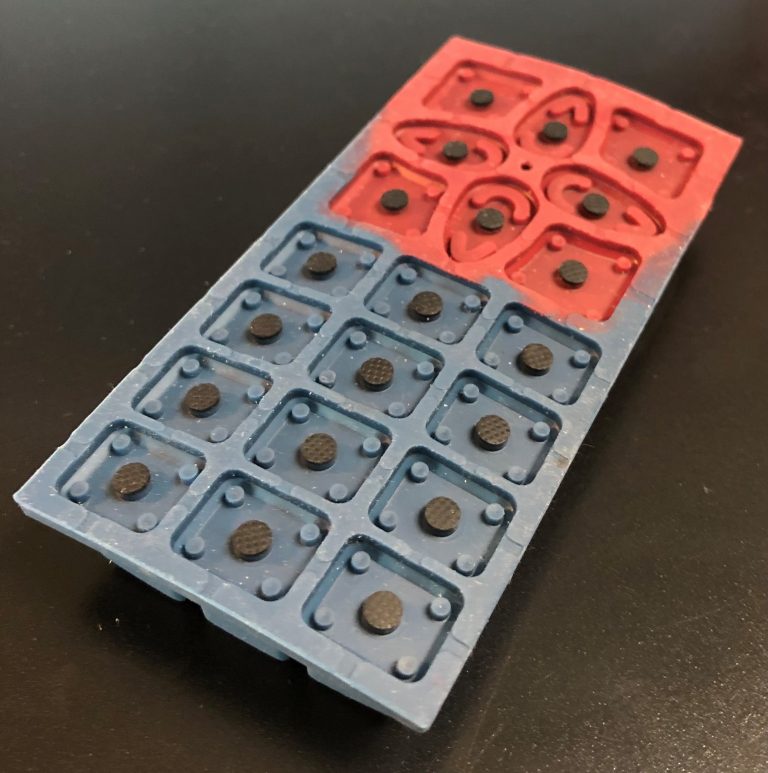How Rubber Keypads help create ergonomic key layouts
Wiki Article
Checking Out the Production Refine Behind Rubber Keypads and Their Value in Modern Tools
Rubber keypads are essential in the functionality of contemporary gadgets. Their production process entails mindful selection of materials and precise methods. Keypads are designed to enhance individual communication while guaranteeing resilience and reliability. Comprehending exactly how these elements are made exposes their value throughout various applications. What aspects contribute to their performance, and how do these components influence individual experience? The answers may improve understandings of this daily innovation.Overview of Rubber Keypads and Their Applications

Rubber keypads are versatile elements widely utilized in different digital tools, varying from consumer electronic devices to commercial tools. Their style permits a responsive feedback, making them a perfect selection for applications needing user interaction. Generally found in products such as remotes, calculators, and medical devices, rubber keypads assist in simplicity of usage and ease of access.
In industrial setups, they serve vital functions in machinery and control panels, where toughness and resistance to ecological variables are essential. The non-slip surface area enhances hold, advertising dependability sought after conditions. Furthermore, their light-weight nature and personalized forms enable makers to produce tailored solutions that fit details needs. With improvements in innovation, rubber keypads remain to develop, including features like backlighting and improved level of sensitivity. Generally, their adaptability and functional advantages contribute significantly to the effectiveness of different tools throughout multiple sectors.
Materials Utilized in Rubber Keypad Production
Keypad producing depends on a selection of products that improve both capability and durability. The main product utilized in the manufacturing of rubber keypads is silicone rubber, understood for its superb resilience and flexibility. This material enables keypads to withstand repeated pushing without losing form or performance. Furthermore, thermoplastic elastomers (TPE) are commonly made use of as a result of their ease of molding and capability to provide a soft-touch feel.Coloring agents, such as pigments, are included to guarantee vibrant, lasting tones that boost visual appeal. Furthermore, ingredients like anti-UV representatives and fire retardants may be mixed into the rubber to enhance weather resistance and safety and security compliance. The choice of products directly impacts the keypad's responsive action, durability, and total efficiency in various devices. Eventually, the cautious selection of these components is vital for the manufacturing of top quality rubber keypads that meet customer and industry demands.
The Layout Process of Rubber Keypads
When developing rubber keypads, the layout procedure plays a necessary function in establishing functionality and customer experience. Developers start by specifying the keypad's intended use, thinking about factors such as the gadget it will certainly come with and the target individual demographic. This initial stage includes sketching formats that focus on ergonomic facets, guaranteeing the secrets are quickly obtainable and suitably spaced.Next, designers concentrate on the tactile feedback desired from the keypads, which influences the choice of products and vital shapes. Prototyping is crucial in this phase, enabling developers to test different styles for comfort and responsiveness.

Manufacturing Techniques for Rubber Keypads
The manufacturing procedure for rubber keypads entails a collection of exact techniques that assure top quality and capability. Liquid silicone rubber (LSR) is typically used due to its resilience and adaptability. The process begins with mixing the raw materials, consisting of silicone, colorants, and curing agents. This mixture is then infused right into mold and mildews designed to shape the keypads properly.
Adhering to injection, the molded keypads undertake treating, a heating process that solidifies the material (Rubber Keypads). This is generally done in a press, guaranteeing the keypads achieve the wanted hardness and strength

Top Quality Control Procedures in Production
To guarantee that rubber keypads satisfy high criteria of high quality and functionality, extensive quality assurance procedures are carried out throughout the manufacturing procedure. These procedures start with raw material assessment, making certain that just the highest-grade elastomers are made use of. During the production stage, drivers conduct normal checks to keep track of parameters such as temperature level, stress, and blending times, crucial for achieving consistent item quality.Post-production, each batch of keypads undergoes thorough screening, including tactile action assessments and resilience tests to review performance under various problems. Visual evaluations are likewise conducted to determine any kind of issues, such as bubbles or variances in appearance. Additionally, conformity with industry requirements is validated, ensuring that the keypads meet safety and security and capability benchmarks.
The Function of Innovation in Keypad Growth
Technology plays a necessary function in the development of rubber keypads by allowing innovative production methods that improve precision and efficiency. Additionally, cutting-edge product selection permits for improved sturdiness and responsiveness in keypad efficiency. These improvements not just enhance production yet additionally boost the general high quality of the final item.Advanced Production Techniques
Innovations in manufacturing techniques revolutionize the production of rubber keypads, boosting both effectiveness and accuracy. Technologies such as shot molding and 3D printing have changed typical procedures, enabling makers to produce complicated designs with reduced waste and enhanced turn-around times. Automation plays an important duty in this advancement, improving production line and decreasing human error. Furthermore, computer-aided layout (CAD) software application enables for elaborate customization, ensuring that keypads fulfill specific user demands. Quality assurance steps have actually likewise advanced, including real-time tracking systems that find problems early in the manufacturing cycle. These innovations not just enhance the resilience and capability of rubber keypads yet likewise support the growing need for personalized services in numerous industries, from customer electronic devices to auto applications.Cutting-edge Material Choice
The advancement of making techniques has actually led the way for innovative product selection in rubber keypad development. Advancements in polymer scientific research have introduced products that enhance longevity, adaptability, and tactile feedback. Manufacturers now make use of polycarbonate elastomers (TPE) and page silicone compounds, which give premium resistance to use and ecological factors. These products permit the development of keypads that can endure extended usage while maintaining visual charm. Furthermore, the integration of additives and finishings enhances performance, such as improving hold and lowering rubbing. The choice of products is important, as it straight influences the efficiency and long life of keypads in numerous tools, from customer electronic devices to commercial tools. This innovative strategy continues to shape the future of keypad design and usability.The Impact of Rubber Keypads on User Experience
Rubber keypads considerably affect user experience through their enhanced tactile feedback, which enables even more accurate interaction. Furthermore, their toughness and durability add to constant performance in time, lowering the need for frequent substitutes. This combination of functions makes rubber keypads a preferred selection in various applications, ultimately impacting customer satisfaction.Boosted Tactile Action
Enhancing tactile response significantly affects user experience, especially in devices that rely upon keypads for interaction. Rubber keypads provide a distinct mix of softness and durability, permitting customers to feel distinct feedback with each press. This comments reinforces a sense of control and accuracy, critical in applications varying from smart devices to industrial equipment. Users typically report better satisfaction and performance when interacting with devices that include well-designed rubber keypads, as they promote quicker and a lot more exact input. Additionally, the ergonomic design of these keypads can minimize finger exhaustion, advertising longer usage durations without discomfort. Generally, the improved responsive feedback offered by rubber keypads significantly contributes to an extra check out this site pleasurable and instinctive individual experience in modern technology.Longevity and Long life
An essential facet of customer experience with rubber keypads lies in their sturdiness and durability. These keypads are created to withstand comprehensive usage, standing up to deterioration that frequently influences other products. The durable nature of rubber warranties that keypads maintain dig this their capability and appearance in time, which is essential for tools often made use of in various settings. Individuals take advantage of the integrity of rubber keypads, as they can endure direct exposure to dust, wetness, and temperature level fluctuations without degrading. This resilience not only improves customer fulfillment however additionally minimizes the demand for frequent substitutes, eventually adding to cost-effectiveness for producers. Basically, the toughness of rubber keypads greatly affects the overall efficiency and user experience in modern gadgets.Regularly Asked Inquiries
For How Long Do Rubber Keypads Normally Last in Instruments?
Rubber keypads generally last between 5 to one decade, depending upon use, ecological factors, and high quality of products made use of (Rubber Keypads). Routine damage can shorten their life expectancy, influencing performance and individual experience in timeCan Rubber Keypads Be Personalized for Particular Applications?
Rubber keypads can undoubtedly be tailored for details applications, allowing modifications in dimension, texture, shape, and color. This versatility enables makers to produce customized remedies that satisfy varied customer demands and enhance capability in numerous gadgets.Are Rubber Keypads Eco-friendly?
Rubber keypads are usually not considered eco-friendly as a result of their petroleum-based materials. Innovations in lasting manufacturing techniques and the growth of bio-based options are slowly boosting their environmental influence in different applications.What Prevail Problems Encountered Throughout Rubber Keypad Manufacturing?
Usual issues encountered throughout rubber keypad production include irregular material quality, mold and mildew flaws, improper healing times, adhesion failures, and challenges in accomplishing accurate tactile responses. These troubles can lead to lowered item performance and consumer frustration.How Do Rubber Keypads Compare to Other Kinds Of Secret Changes?
Rubber keypads offer a softer feel and quieter operation contrasted to mechanical buttons, which supply responsive comments. Nevertheless, rubber keypads may break faster and do not have the accuracy that some individuals like in high-performance applications.The primary material utilized in the production of rubber keypads is silicone rubber, recognized for its excellent durability and versatility. When producing rubber keypads, the layout procedure plays an essential function in determining performance and individual experience. Rubber keypads substantially influence customer experience via their enhanced responsive response, which allows for even more precise interaction. Users frequently report higher fulfillment and effectiveness when interacting with gadgets that feature properly designed rubber keypads, as they promote quicker and much more exact input. A vital facet of user experience with rubber keypads lies in their resilience and longevity.
Report this wiki page